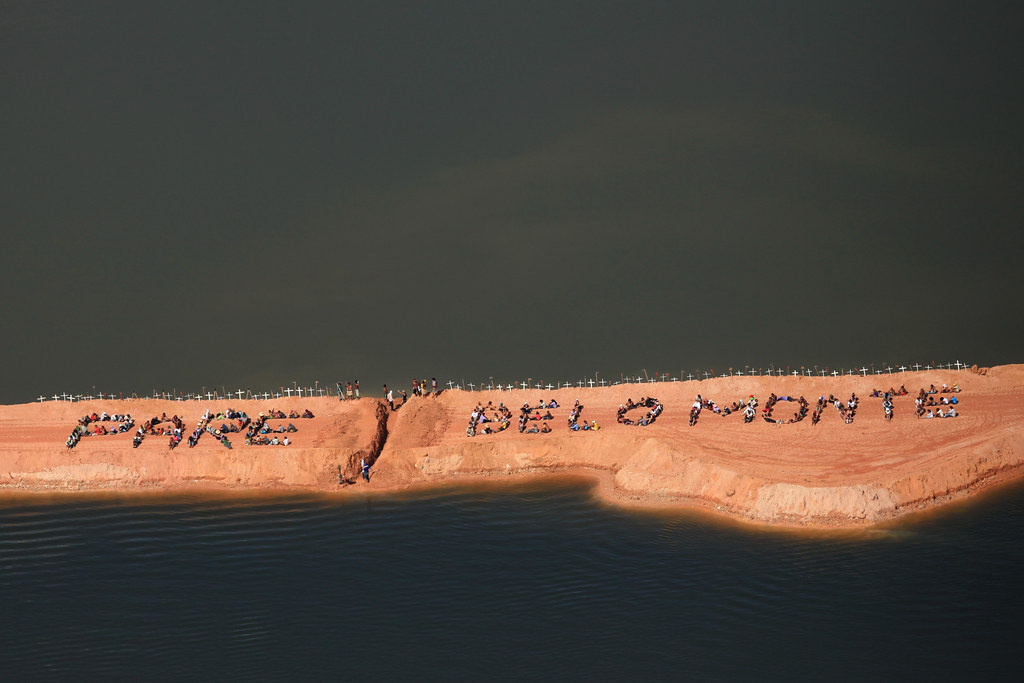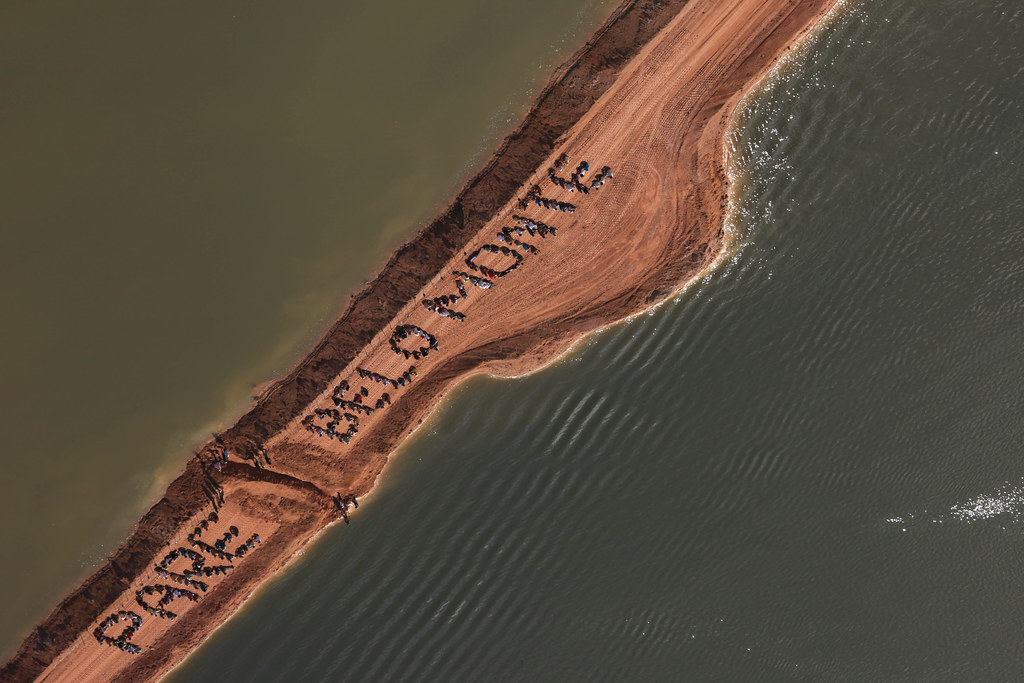居住亞馬遜流域受到美山水壩(Belo Monte)興建工程影響的300名婦女及孩童,6月15日起藉由象徵性的大壩場址佔領活動,提出「讓欣古河(Xingu River)自由」訴求。
近期興建的臨時土壩阻塞了欣古河水道,原住民、農夫、漁民、行動者及當地區民遊行到該處,以斧頭及鏟子在臨時壩上挖出一條渠道,恢復河流的自然水道。
示威者用身體排出「Pare Belo Monte」(停建美山水壩)字樣,以停止興建款達180億元的美山水壩為訴求。

他們的目標是在傳達訊息給全世界:在確保現今近70億人的需求發展的同時,必須承諾為子孫後代保護地球。
示威者在欣古河堤上豎立了200個十字架以紀念捍衛亞馬遜而喪失的生命。同時,在工程初期所摧毀的堤岸種植500棵可固堤的原生棕櫚樹。
民眾聚集在「北方能源」集團行動基地的聖安東尼奧社區,及容納受到大壩影響的13萬人口的新興都市阿爾塔米拉。一旦大壩興建完成,將成為世界第三大水力發電設施。
示威民眾用身體拼出Pare Belo Monte 字樣作為傳遞給政府停止興建大壩的訊息。
欣古運動協調員Antonia Melo表示,「這場戰役將會持續下去。我們的訴求是:我們希望河流保持活力、大壩不該興建、我們這些住在欣古河畔的人靠這條河維生,我們飲用這條河水,而我們將因這個巴西史上最不負責任的計畫而受苦。停建美山水壩!」
受到大壩影響當地原住民祖魯拿族(Juruna)的領袖Sheyla Juruna表示:「現在正是時候!巴西政府正在宰割欣古河並摧毀原住民的生計。我們必須送出我們的訊息表示我們不會沈默以待、這是我們的領域。我們發誓用我們的方式採取行動來停止停建美山水壩。至終我們將會捍衛我們的河流!」
亞馬遜河流域規劃了約70個大型水壩,美山水壩是其中之一。
美山水壩的示威者指出,巴西政府聲稱亞馬遜的水壩將成為「綠色經濟」的「乾淨能源」來源,這與事實有極大的差異。
巴西官方在里約強調,巴西使用的水力發電是一種乾淨、永續的電力來源。去年巴西的電力有44%是由水力、風力、酒精及生質能提供,而全世界的平均值是13..3%。
負責研究並支持能源部門規劃的公共機構「巴西能源調查公司」(Empresa de Pesquisa Energetica)總裁Mauricio Tolmasquim表示:「水力發電在巴西的能源配置中分擔了重要的角色。」
Tolmasquim 14日表示:「巴西擁有世界第三大的水力發電潛力,僅落後於中國及俄國。目前僅開發了1/3的潛力。由於多數尚未開發的潛力點位於亞馬遜河流域(擁有了豐富的生物多樣性必須被保存),我們面臨了一些挑戰。但保護亞馬遜及興建大壩兩者間並不相牴觸。」
示威者警告,巴西的大壩興建計畫不僅使得生物多樣性承擔風險,且將「對世界上最珍貴的生物群落及其居民造成不可逆的毀壞。」
美山水壩將會把欣古河80%流量導引至人工運河,在造成原河床綿延100公里的彎區乾旱的同時,將淹沒600平方公里的雨林。這些地方是許多原生及水域物種的棲息地。
示威者表示,儘管該計畫已被「當成乾淨能源販賣給大眾」,美山水壩運轉將會產生大量的甲烷,甲烷是比二氧化碳影響更大的溫室氣體。水庫注水將導致現有森林、植群的死亡及分解,腐爛的有機物會釋放大量的二氧化碳進入大氣。腐爛的植物將沉到水庫底部,在分解過程釋放出甲烷。
As Brazil hosts the Rio+20 UN summit on sustainable development in Rio de Janeiro, in the Amazon region 2,000 miles to the north 300 women and children affected by construction of the giant Belo Monte Dam Friday began a symbolic occupation of the dam site to "free the Xingu River."
Indigenous peoples, farmers, fisherfolk, activists and local residents marched onto a temporary earthen dam recently built to block the flow of the Xingu River. With pick axes and shovels they opened a channel in the earthen dam to restore the river's natural flow.
Demanding the cancellation of the $18 billion Belo Monte Dam project, demonstrators positioned their bodies to spell out the words "Pare Belo Monte" meaning "Stop Belo Monte."
They aim to send a message to the world before 134 world leaders gather in Rio June 20 to 22 to make commitments to ensure development that protects the planet for future generations while serving the needs of today's nearly seven billion people.
A delegation of international observers and human rights advocates, including Brazilian actor Sergio Marone of the Drop of Water Movement, came to witness and raise awareness of the protest.
Demonstrators erected 200 crosses on the banks of the Xingu to honor the lives of those lost defending the Amazon. They planted 500 native acai trees to stabilize the riverbank that has been destroyed by the initial construction of the Belo Monte Dam.
Also Friday morning, hundreds of Altamira residents marched to the headquarters of dam-building consortium Norte Energia, NESA.
The actions are part of Xingu+23, a multi-day series of festivities, debates and actions to mark 23 years since the residents of the Xingu first defeated the original Belo Monte Dam proposal.
Residents have been gathering in the community of Santo Antonio, a hamlet displaced by the consortium's base of operations and in Altamira, a boomtown of 130,000 affected by the dam, which if completed would be the world’s third-largest hydroelectric project.
Antonia Melo, coordinator of Xingu Vivo Movement said, "This battle is far from being over. This is our cry: we want this river to stay alive. This dam will not be built. We, the people who live along the banks of the Xingu, who subsist from the river, who drink from the river, and who are already suffering from of the most irresponsible projects in the history of Brazil are demanding: Stop Belo Monte."
Sheyla Juruna, a leader from the Juruna indigenous community affected by the dam said, "The time is now! The Brazilian government is killing the Xingu River and destroying the lives of indigenous peoples. We need to send a message that we have not been silenced and that this is our territory. We vow to take action in our own way to stop the Belo Monte Dam. We will defend our river until the end!"
The Belo Monte Dam is one of about 70 large dams planned for the Amazon Basin.
The demonstrators at Belo Monte are pointing to the gap between reality and the Brazilian government's rhetoric about Amazon dams as a source of "clean energy" for a "green economy."
In Rio, Brazilian government officials are highlighting Brazil's use of hydropower as a clean, sustainable source of electricity. Last year, Brazil generated 44 percent of its electricity using sources such as hydropower, wind, ethanol and biomass in its energy matrix, while the world average is 13.3 percent.
"The share of hydroelectricity is one of the highlights of the Brazilian energy matrix," attendees heard from Mauricio Tolmasquim, president of the Empresa de Pesquisa Energetica, the public agency responsible for research that supports energy sector planning.
"The country has the third largest hydroelectric potential in the world, behind China and Russia, and so far only used one third of this potential," Tomasquim said Thursday. "Of course we have a challenge because much of what remains to be explored is in the Amazon region, which has a wealth of biodiversity that must be preserved. But is not incompatible in order to preserve the Amazon and the construction of dams."
The protesters warn that more than biodiversity is at risk and Brazil's dam-building plans will have "devastating and irreversible consequences for one of the world's most precious biomes and its peoples."
The Belo Monte dam would divert 80 percent of the Xingu River's flow through artificial canals, flooding over 600 square kilometers (232 square miles) of rainforest while drying out a 100-kilometer (60-mile) stretch of the river known as the Big Bend, which is home to hundreds of indigenous and riverine families.
Protesters say that although it has been "sold to the public as clean energy," the Belo Monte dam would generate an enormous amount of methane, a greenhouse gas many times more potent than the most abundant greenhouse gas carbon dioxide.
The initial filling of a reservoir floods the existing forest, leading to the death and decomposition of the carbon-rich plants and trees. The rotting organic matter releases large amounts of carbon dioxide into the atmosphere. The decaying plant matter then settles to the bottom of the reservoir, and its decomposition releases dissolved methane.
全文及圖片詳見:ENS報導








